- Homepage > Services > Periodontics (Gum Treatment)
PERIODONTICS (GUM TREATMENT)
Imagine a house (your teeth) sitting on a foundation that is infested with termites (gum disease). Eventually, the entire structure would suffer and collapse. Your smile is like that, too. Research has also linked gum disease to many health conditions, including diabetes, heart disease, pregnancy complications and cancer.
Our visiting periodontist specialises in the treatment of advanced gum disease called periodontitis and she works closely with our consultant orthodontist in the management of teeth alignment problems as a result of periodontitis and/or loss of teeth. She offers periodontal screening and treatment prior to denture construction, crown and bridge, and orthodontic treatment. She works with your dentist as part of a dental team to manage your periodontal concerns.
If you noticed that your teeth are getting loose but with no associated pain and discomfort, you are not alone. One of the challenges for early detection of periodontitis is its “silent” nature – the disease does not cause pain and can progress unnoticed. Request for a BPE (Basic Periodontal Examination) today – it only takes 2 minutes! It is time to break the silence for this silent disease.
Periodontal Screening,
Diagnosis and
Treatment Planning
Let’s face it – how many of us have heard of periodontal screening? No, we are not referring to your dentist examining your teeth for cavities. We are referring to your gum health. Yes, you heard it right. Oral health encompasses a range of diseases and conditions which include dental caries as well as periodontal disease (World Health Organization). In fact, the 2001 Guinness Book of World Records has listed Periodontal Disease as the #1 disease affecting mankind.
In Malaysia, 9 out of 10 dentate adults have some form of periodontal disease, and this has not changed for the past 20 years. The prevalence of the severe form of periodontitis was also found to have increased from 6% in 1990 to 17.8% in 2010, which means 1 out of 5 of us are suffering from severe periodontitis!1. There are many reasons for this – people are living longer, increase retention of teeth due to increase awareness of oral health and improved dental services in the country.
| Periodontal status | 1990 (%) | 2000 (%) | 2010 (%) |
|---|---|---|---|
| Periodontal disease all levels of severity | 92.8 | 90.2 | 94.0 |
| Infection of the gum only | N/A | 4.2 | 4.8 |
| Calculus | 65.1 | 56.9 | 42.2 |
| Severe periodontal disease | 6.0 | 5.5 | 18.2 |
Table showing the prevalence of periodontal disease in Malaysia in the year 1990, 2000 and 2010 (Source: National Oral Healthy Survey in Adults 2010 (NOHSA 2010), Oral Health Division, Ministry of Health)
Warning signs

Risks factors

What can you do to prevent or control periodontal disease?

Reference: http://www.myhealth.gov.my/en/periodontal-disease-amongst-malaysian/
What happens during periodontal screening?

Before we talk about periodontal screening, you need to know what is considered as healthy gums. Healthy gums are attached firmly to your teeth, with just a minimal space of 2-3mm called the gingiva sulcus or crevice. Gingivitis, which is the early stage of gum disease, develops when there is a long-standing plaque accumulation at the gum line, causing gum swelling and bleeding. If you have periodontitis, your gums will slowly detach from your teeth, increasing the space between your gums and your teeth to over 4mm. This space is now called a gum/periodontal pocket.
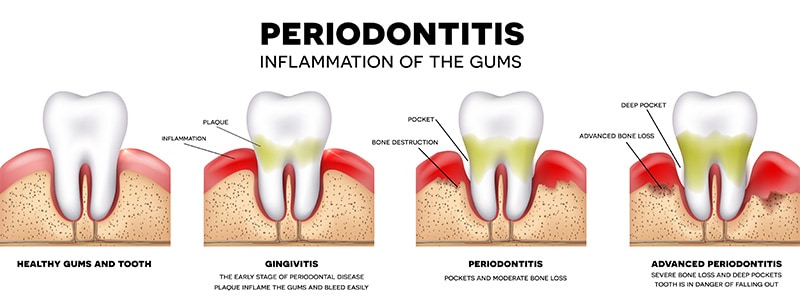
Periodontal screening involves running an instrument called a probe (which is like a dentist’s ruler) gently between your gums and teeth to detect or measure periodontal pockets. You may have periodontal pockets on certain teeth (localised periodontitis) or most of your teeth (generalised periodontitis). If your gums are not healthy, some bleeding from the gums is expected during the screening procedure but overall, most people are able to tolerate it well. Plus it only takes 2 minutes (or less!)

How is periodontal disease diagnosed?
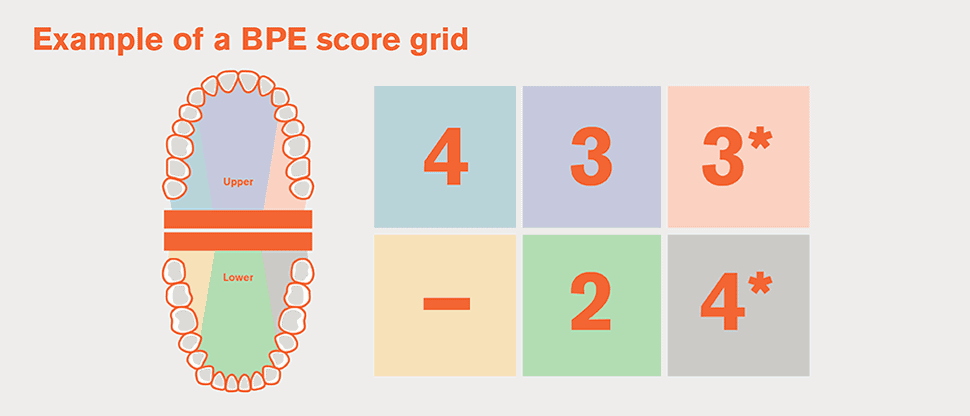
BPE stands for Basic Periodontal Examination (Source: https://www.gskhealthpartner.com/en-sa/oral-health/conditions/gum-health/diagnosis/)
If your screening shows a score of 3 and 4, you will need a full mouth periodontal assessment. This involves the measurement and recording of periodontal pockets at six sites per tooth. If the periodontal pocket around your teeth measures to 4mm or more, you have periodontitis. This is important as it will serve as a baseline to compare your future response to treatment. This is an example of a full mouth periodontal assessment sheet to compare your periodontal condition before (Chart 1) and after treatment (Chart 2)
A panoramic radiograph will also be useful to assess the bone levels supporting your teeth and this will help with your overall treatment planning. This is an example of a panoramic radiograph of a periodontitis patient. The solid red lines represents the original bone level (i.e. at the neck of the tooth), while the dotted red lines represents the reduced bone level as a result of periodontitis
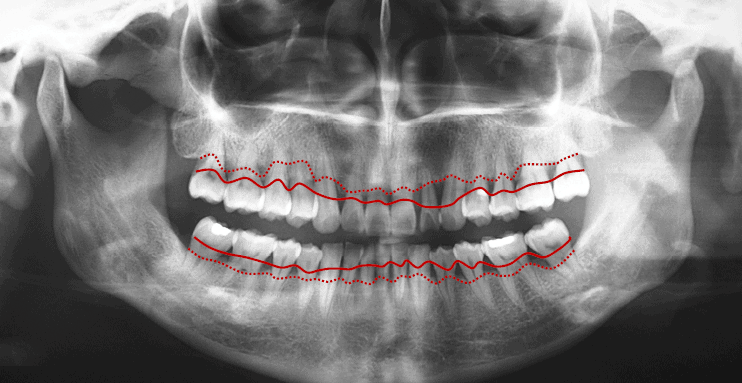
Non-Surgical
Periodontal Therapy

Before non-surgical periodontal therapy (blue arrows show areas of gum swelling and bleeding)
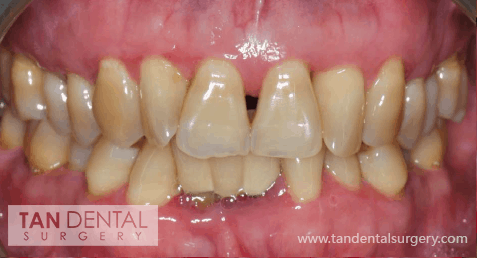
After non-surgical periodontal therapy
The first line of treatment of periodontitis is non-surgical periodontal therapy, which involves the removal of plaque and tartar on the root surfaces of teeth, using ultrasonic scaling and hand instruments. The purpose of this procedure is to create a clean and smooth root surface so that your gums can re-attach to it, thus reducing the depths of the periodontal pockets.
Many people ask how is this different from scaling and polishing? Scaling and polishing usually refers to cleaning above and at your gums. Non-surgical periodontal therapy refers to cleaning the root surfaces of teeth underneath your gums under local anaesthetic. If you have periodontitis, regular scaling and polishing will not be able to control your disease, as your gums will not be able to re-attach to a contaminated root surface. Having said that, regular scaling and polishing is essential in maintaining your periodontal health, once you have completed active periodontal therapy.
Surgical
Periodontal Therapy
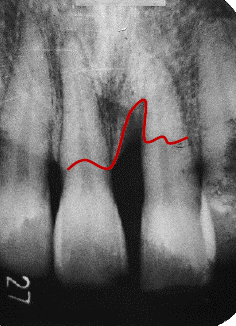
Before Guided Tissue Regeneration (solid red line shows a bony defect adjacent to an incisor tooth as a result of periodontitis)
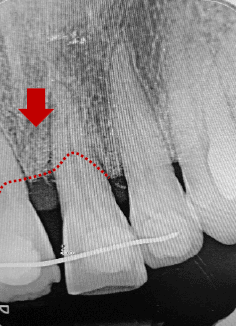
After Guided Tissue Regeneration (dotted red line shows increased bone levels after repairing the bony defect with bovine-derived particulate grafts and membrane, red arrow shows area of the defect filled with bone)
Most people respond well to non-surgical periodontal therapy. However, for some people, for certain teeth, their gums refuse to re-attach back to the root surfaces despite multiple sessions of non-surgical treatment. The most frequent cause of this is retained tartar that is inaccessible non-surgically due to the complexity of root surfaces. For these cases, surgical periodontal therapy is the next line of treatment. The purpose of this procedure (also known as open flap debridement) is to gain access to the hard-to-reach areas for cleaning.
Supportive Periodontal
Therapy/ Maintenance
Following active periodontal therapy, supportive periodontal therapy or periodontal maintenance will help you maintain your periodontal health – the same way as how regular maintenance of your car helps to extend the life of your vehicle.
Periodontal maintenance involves scaling and polishing, oral hygiene reinforcements and monitoring for disease recurrence. These visits may be scheduled every few weeks or as far apart as once a year. Most people with a history of periodontitis start with a three-month periodontal maintenance schedule.
We look forward to seeing you!
RELATED SERVICES
RELATED BLOGS
Book Your Appointment Today






